Nikon COOLSHOT 40i Instruction Manual
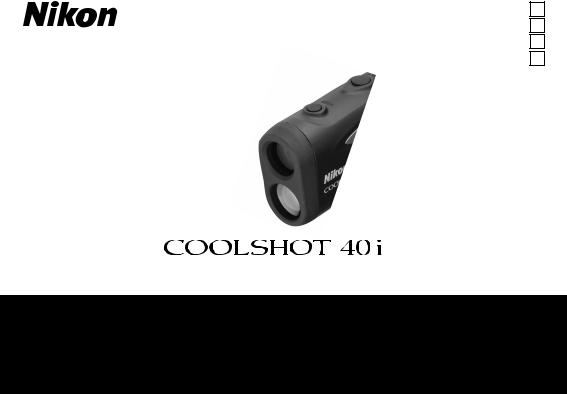
En
Es
Fr
Pt
Instruction manual/Manual de instrucciones/ Manuel d’utilisation/Manual de instruções
English .......................................... |
p. 3-18 |
Español ....................................... |
p. 19-34 |
Français ...................................... |
p. 35-50 |
Português brasileiro .................. |
p. 51-66 |

|
|
CONTENTS |
|
|
1. |
Introduction .............................................................. |
3-4 |
English |
2. |
Cautions before use ................................................ |
5-7 |
3. |
Key features ................................................................... |
8 |
|
|
4. |
Nomenclature/Composition ................................... |
9 |
|
5. |
Internal display ........................................................... |
10 |
|
6. |
Measurement display mode ................................. |
11 |
|
7. |
Target priority mode................................................. |
12 |
|
8. |
Distance display units .............................................. |
12 |
|
9. |
Battery ........................................................................... |
13 |
|
10. |
Measurement ....................................................... |
14-15 |
|
11. |
Specifications ....................................................... |
16-17 |
|
12. |
Troubleshooting/Repair .......................................... |
18 |
1. Introduction
Thank you for purchasing the Nikon Laser Rangefinder COOLSHOT 40i.
Before using this product, please read these instructions thoroughly to ensure correct usage. After reading, please keep this manual handy for easy reference.
Es
Fr
Pt
3

Es
Fr
Pt
● About the manual
No part of the manual included with this product may be reproduced, transmitted, transcribed, stored in a retrieval system, or translated into any language in any form, by any means, without Nikon’s prior written permission.
Nikon will not be held liable for any errors this manual may contain.
The appearance of this product and its specifications are subject to change without notice.
●About controls for radio interference
This device complies with Part 15 of the FCC Rules. Operation is subject to the following two conditions:
(1)This device may not cause harmful interference, and
(2)This device must accept any interference received, including interference that may cause undesired operation.
This equipment has been tested and found to comply with the limits for a Class B digital device, pursuant to Part 15 of the FCC Rules and to EU EMC directive. These limits are designed to provide reasonable protection against harmful interference in a residential installation. This equipment generates, uses and can radiate radio frequency energy and, if not installed and used in accordance with the instructions, may cause harmful interference to radio communications. However, there is no guarantee that interference will not occur in a particular installation. If this equipment does cause harmful interference to radio
or television reception, which can be determined by turning the equipment off and on, the user is encouraged to try to correct the interference by one or more of the following measures:
•Reorient or relocate the receiving antenna.
•Increase the separation between the equipment and receiver.
•Consult the dealer or an experienced radio/TV technician for help.
This Class B digital apparatus meets all requirements of the Canadian Interference-Causing Equipment Regulations.
●About measurement results
This Nikon Laser Rangefinder is a basic rangefinder. Its results cannot be used as official evidence.
4

2. Cautions before use
Please observe the following guidelines strictly so you can use the equipment properly and avoid potentially hazardous problems. Before using this product, read thoroughly the “Cautions before use” and instructions on correct usage accompanying the product. Keep this manual within reach for easy reference.
 WARNING
WARNING
This indication alerts you to the fact that any improper use ignoring the contents described herein can result in potential death or serious injury.
 CAUTION
CAUTION
This indication alerts you to the fact that any improper use ignoring the contents described herein can result in potential injury or material loss.
SAFETY PRECAUTIONS (Laser)
The Nikon Laser Rangefinder uses an invisible laser beam. Be sure to observe the following:
 Warning
Warning
•Do not press the POWER ON/ Measurement button while looking into the optics from the
objective side. Failure to do this may negatively affect or damage your eyes.
•Do not aim at the eye.
•Do not point the laser at people.
•Do not look at the laser with another optical instrument such as through lenses or binoculars, nor with the naked eye. This may result in damage to the eyes.
•When not measuring, please keep your fingers away from the POWER ON/Measurement button to avoid accidentally emitting the laser beam.
•When not in use for an extended period, please remove the battery from the body.
•Do not disassemble/remodel/ repair the Nikon Laser Rangefinder. The emitting laser may be harmful to your health. A product that has been disassembled/remodeled/
repaired is not guaranteed by the manufacturer.
•Keep the Nikon Laser Rangefinder out of reach of children when stored.
•If the Nikon Laser Rangefinder’s body cover is damaged, or if it emits a strange sound due to dropping or some other cause, remove the battery immediately and stop using.
Es
Fr
Pt
5

Es
Fr
Pt
SAFETY PRECAUTIONS (Monocular)
The Nikon Laser Rangefinder employs a monocular in its optical system in order to aim at the target. Be sure to observe the following:
 Warning
Warning
•Never look directly at the sun, an intense light or the laser beam when using the Nikon Laser Rangefinder.
 Cautions
Cautions
•When not using the Nikon Laser Rangefinder, do not push the POWER ON/Measurement button.
•Do not use this product while walking. Failure to observe this may cause injury or malfunction as a result of walking into something, hitting others, falling or other accidents.
•Do not swing around by the strap. This may result in hitting others and cause injury.
•Do not place this product in an unstable place. Failure to
observe this may result in falling or dropping and cause injury or malfunction.
•Keep the plastic bag used to wrap this product or other small parts out of reach of children.
•Prevent children from putting the rubber eyecup or small parts, etc. into their mouths. If children swallow such parts, consult a doctor immediately.
•If using the rubber eyecup for a long period of time, some people may suffer skin inflammation. If any symptoms occur, stop using it and consult a doctor immediately.
•When carrying the Nikon Laser Rangefinder, store it in the case.
•If your Nikon Laser Rangefinder should fail to operate correctly, discontinue use immediately and consult with your local dealer for instructions on where to send it for repair.
SAFETY PRECAUTIONS (Lithium battery)
If handled incorrectly, the battery may rupture and leak, corroding equipment and staining clothing. Be sure to observe the following:
•Install the battery with the + and – poles positioned correctly.
•The battery should be removed when exhausted or during extended periods of non-use.
•Do not short the end terminal of the battery chamber.
•Do not carry together with keys or coins in a pocket or bag, it may short and cause overheating.
•Do not expose the battery to water, or a flame. Never disassemble the battery.
•Do not charge the lithium battery.
•If liquid from a damaged battery comes into contact with clothing or skin, rinse immediately with plenty of water. If liquid from a damaged battery enters the eyes, rinse immediately with clean water, then consult a doctor.
•When disposing of the battery, follow your local area regulations.
6
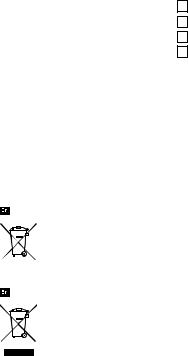
SAFETY PRECAUTIONS
 Cautions
Cautions
•It is not designed for use underwater.
•Rain, water, sand and mud should be removed from the rangefinder body surface as soon as possible, using a soft, clean cloth.
•Do not leave the Nikon Laser Rangefinder in a car on a hot or sunny day, or near heat-generating equipment. This may damage or negatively affect it.
•Do not leave the Nikon Laser Rangefinder in direct sunlight. Ultraviolet rays and excessive heat may negatively affect or even damage the unit.
•If the Nikon Laser Rangefinder is exposed to sudden changes in temperature, water condensation may occur on lens surfaces. Do not use the product until the condensation has evaporated.
CARE AND MAINTENANCE
Lenses
•When removing dust on the lens surface, use a soft oil-free brush.
•When removing stains or smudges like fingerprints from the lens surface, wipe the lenses very gently with a soft clean cotton cloth or quality oil-free lens tissue. Use a small quantity of pure alcohol (not denatured) to wipe stubborn smudges. Do not use velvet cloth or ordinary tissue, as it may scratch the lens surface. Once the cloth has been used for cleaning the body, it should not be used again for the lens surface.
Main body
•Clean the body surface with a soft, clean cloth after blowing away dust with a blower* lightly. Do not use benzene, thinner, or other cleaners containing organic solvents.
*A blower is rubber cleaning equipment that blows air from a nozzle.
Storage |
|
|
|
||
• Water condensation or mold may |
Es |
|
occur on the lens surface because |
||
Fr |
||
of high humidity. Therefore, store |
||
the Nikon Laser Rangefinder in a |
Pt |
|
cool, dry place. |
|
|
After use on a rainy day or at night, |
|
|
thoroughly dry it at room |
|
|
temperature, then store in a cool, |
|
|
dry place. |
|
Symbol for separate collection applicable in European countries
This symbol indicates that this battery is to be collected separately.
The following apply only to users in European countries.
•This battery is designated for separate collection at an appropriate collection point. Do not dispose of as household waste.
•For more information, contact the retailer or the local authorities in charge of waste management.
Symbol for separate collection applicable in European countries
This symbol indicates that this product is to be collected separately.
The following apply only to users in European countries.
• This product is designated for separate collection at an appropriate collection point. Do not dispose of as household waste.
•For more information, contact the retailer or the local authorities in charge of waste management.
7

|
3. Key features |
|
• Measurement range of actual distance: |
|
|
Es |
7.5-590 meters/8-650 yards |
• High-quality 6x finder with multilayer coating |
|
Fr |
• Larger ocular for easy viewing |
Pt |
• Select from four measurement display modes, which |
|
can be easily switched. Golf mode displays the slope |
|
adjusted distance (Horizontal distance ± Height) |
|
which is useful for golf. |
•Target priority switching system, which can be chosen according to the target, is employed
•Sustained pressing of the POWER ON/Measurement button enables continuous measurement function
•Automatic power shut-off (after approx. 8 sec. unoperated)
•Default to “Last Use” settings
•Rainproof — JIS/IEC protection class 4 (IPX4) equivalent (under our testing conditions)
•Invisible/Eyesafe EN/IEC Class 1M Laser
The Nikon Laser Rangefinder uses an invisible laser beam for measuring. It measures the time the laser beam takes to travel from the rangefinder
to the target and back. Laser reflectivity and measurement results may vary according to climatic and environmental conditions, as well as the color, surface finish, size, shape and other characteristics of the target.
The following conditions facilitate measuring:
•Cloudy weather
•Bright-colored target
•Large-size target
•When laser incidence to the target’s reflective surface is straight
Measurement may be inaccurate or fail in the following cases:
•In snow, rain or fog
•Small or slender target
•Black or dark target
•Target has stepped surface
•Moving or vibrating target
•When measuring the surface of water
•Target measured through glass
•When the target is glass or a mirror
•When laser incidence to the target’s reflective surface is oblique
8
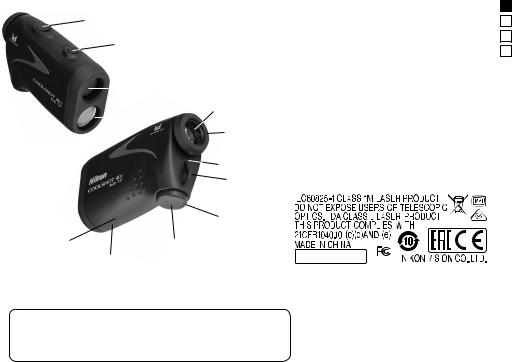
4. Nomenclature/Composition
|
|
|
|
|
|
|
1. |
Monocular objective lens/ |
||||||||||||
|
4 |
|
|
|
||||||||||||||||
|
|
|
|
|
|
|
|
Laser emission aperture |
||||||||||||
|
3 |
|
|
|||||||||||||||||
|
|
2 . Laser detector aperture |
||||||||||||||||||
|
|
|
|
|
|
|
3. |
MODE button |
||||||||||||
|
|
|
|
|
|
|
4. |
POWER ON/Measurement button |
||||||||||||
|
|
|
|
|
1 |
5. |
6x monocular eyepiece |
|||||||||||||
|
|
|
||||||||||||||||||
|
5 |
6. |
Eyecup/Diopter adjustment ring |
|||||||||||||||||
|
7. |
Diopter index |
||||||||||||||||||
|
|
|
2 |
|||||||||||||||||
|
|
|||||||||||||||||||
|
6 |
8. |
Strap eyelet |
|||||||||||||||||
|
|
|
|
|
|
|
9. |
Battery chamber cover “Open” indication |
||||||||||||
|
7 |
10. |
Battery chamber cover |
|||||||||||||||||
|
11. |
Product number label |
||||||||||||||||||
|
8 |
|||||||||||||||||||
|
12. |
Indication |
||||||||||||||||||
|
|
|
|
|
|
|
||||||||||||||
12 |
9 |
|
|
|
|
|
|
|
|
|
|
|
|
|
|
|||||
|
|
|
|
|
|
|
|
|
|
|
|
|
|
|||||||
|
|
|
|
|
|
|
|
|
|
|
|
|
|
|||||||
|
|
|
|
|
|
|
|
|
|
|
|
|
|
|||||||
|
|
|
|
|
|
|
|
|
|
|
|
|
|
|||||||
|
|
|
|
|
|
|
|
|
|
|
|
|
|
|||||||
10 |
|
|
|
|
|
|
|
|
|
|
|
|
|
|
||||||
|
|
|
|
|
|
|
|
|
|
|
|
|
|
|||||||
|
|
|
|
|
|
|
|
|
|
|
|
|
|
|||||||
|
|
|
|
|
|
|
|
|
|
|
|
|
|
|||||||
|
11 |
|
|
|
|
|
|
|
|
|
|
|
|
|
|
|
|
|||
|
|
|
|
|
|
|
|
|
|
|
|
|
|
|
||||||
|
|
|
|
|
|
|
|
|
|
|
|
|
|
|
||||||
Composition
• Body ...................................... |
x1 |
• Strap ...................................... |
x1 |
• Case ....................................... |
x1 |
• Lithium battery (CR2) ...... |
x1 |
Es
Fr
Pt
9
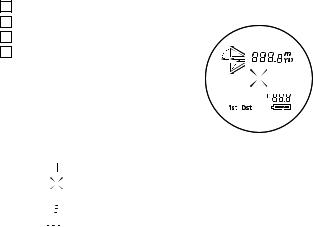
|
5. Internal display |
|
|
|
|
|
|
|
|
|
|
|
|
|
|
|
||||
|
|
|
|
|
|
Distance |
||||||||||||||
|
|
|
|
|
|
|||||||||||||||
Es |
|
|
|
|
|
|
|
|
|
|
|
|
|
|
|
|
|
|
|
|
Fr |
|
|
|
|
|
|
|
|
|
|
|
|
|
|
|
|
|
|
|
|
Pt |
Incline |
|
|
|
|
|
|
|
|
|
|
|
|
|
|
|
|
|
|
Unit of measure (m/yd.) |
|
|
|
|
|
|
|
|
|
|
|
|
|
|
|
|
|
|
|||
|
|
|
|
|
|
|
|
|
|
|
|
|
|
|
|
|||||
|
Decline |
|
|
|
|
|
|
|
|
|
|
|
|
|
|
|
|
|
|
|
|
|
|
|
|
|
|
|
|
|
|
|
|
|
|
|
|
|
|
Target mark |
|
|
|
|
|
|
|
|
|
|
|
|
|
|
|
|
|
|
||||
|
|
|
|
|
|
|
|
|
|
|
|
|
|
|
|
|
|
|
|
Laser irradiation mark |
|
|
|
|
|
|
|
|
|
|
|
|
|
|
|
|
|
|
|
||
|
First Target Priority mode |
|
|
|
|
|
|
|
|
|
|
|
|
|
|
|
|
|
Height |
|
|
|
|
|
|
|
|
|
|
|
|
|
|
|
|
|
|
||||
|
|
|
|
|
|
|
|
|
|
|
|
|||||||||
|
|
|
|
|
|
|
|
|
|
|
|
|
|
|
|
|
(Actual distance at Golf mode setting) |
|||
|
|
|
|
|
|
|
|
|
|
|
|
|
|
|
|
|
|
|||
|
|
|
|
|
|
|
|
|
|
|
|
|
|
|
|
|
|
|
|
|
|
Distant Target Priority mode |
|
|
|
|
|
|
|
|
|
|
|
|
|
|
|
Battery condition |
|||
|
|
|
|
|
|
|
|
|
|
|
|
|
|
|
||||||


 : Aim at the target you want to measure. Position the target at the center of the reticle.
: Aim at the target you want to measure. Position the target at the center of the reticle.
: Appears while the laser is being irradiated for a measurement.
Do not look towards the objective lens side while this mark is shown. : Now measuring
: "Failure to measure" or "Unable to measure"
*Because the internal display of this product is enlarged by the eyepiece, dust may sometimes be seen. This will not, however, affect the measurement accuracy.
10
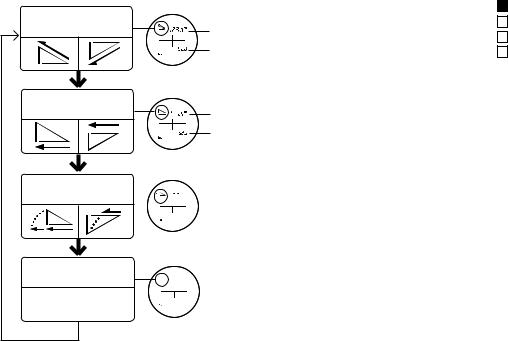
6. Measurement display mode
Actual Distance
and Height Mode
Horizontal Distance
and Height Mode
Golf Mode
Actual Distance
Mode
Actual |
1. Turn on the power. |
|
Distance |
2. Press and hold the MODE button, then |
|
Height |
immediately press the POWER ON/ |
|
Measurement button. |
||
|
||
|
3. Release your finger from the POWER ON/ |
|
|
Measurement button within 2 seconds to |
|
Horizontal |
switch the Measurement display mode. |
|
4. Repeat steps 2 and 3 to switch measurement |
||
Distance |
display mode in rotation. |
|
Height |
* If the buttons are not pressed in the correct |
|
|
order, switching will not take place. |
Slope Adjusted











 Distance*
Distance*




 Actual
Actual
Distance
* (Horizontal distance ± Height)
Actual






 Distance
Distance
Es
Fr
Pt
11

7. Target priority mode |
8. Distance display units |
Es
Fr
Pt
This Nikon Laser Rangefinder employs the First Target Priority/Distant Target Priority switching system (Factory default setting is First Target Priority mode).
First Target Priority mode |
|
|
|
Distant Target Priority mode |
|
|
|
|
|||
[ ] |
|
|
|
[ |
] |
|
|
|
|||
|
|
|
|
|
|
1.Turn on the power.
2.Press and hold the MODE button, then press and hold the POWER ON/Measurement button.
Continue to press and hold both buttons (for more than two seconds) until Target Priority modes are switched.
3.Release both buttons after the mode has switched.
*If the buttons are not pressed in the correct order, switching will not take place.
[First Target Priority mode/Distant Target Priority mode]
When measuring overlapping subjects, First Target Priority mode displays the distance of the closest subject and Distant Target Priority mode displays that of the farthest subject.
Measurement results are displayed in yards/meters. (Factory default setting is yard.)
Yard [ |
] |
|
|
|
Meter [ ] |
|
|
|
|||
|
|
|
1.Turn on the power.
2.Press and hold the MODE button for more than two seconds. After the display unit has switched, release the button.
12

9.Battery
1.Type of battery
3V CR2 lithium battery x1
2.Inserting/replacing battery
2-1. Open the battery chamber cover
Rotate the battery chamber cover counterclockwise and remove it. It may not open easily due to its rubber packing for water resistance.
2-2. Insert the battery/Replace the old battery with a new one
Insert a new battery correctly positioned following the indication seal inside the chamber. The [+] pole should be positioned toward the inside of the chamber. If the battery is not inserted correctly, the Nikon Laser Rangefinder will not operate. When replacing the battery, remove the old battery then insert a new one.
2-3. Close the battery chamber cover
Rotate the battery chamber cover clockwise to screw it into the body. It may not close easily due to the rubber packing for water resistance, but continue to turn it all the way until it stops. Confirm that the cover is securely closed.
3.Battery level indicator
* The battery condition mark in the internal display warns when the battery needs to be replaced.
|
Display |
Description |
|
|
|
|
After power on, displays for 2 seconds only. |
Sufficient power available. |
|
|
|
|
After power on, displays for 2 seconds only. |
Power getting low. |
|
Prepare to replace the battery. |
|
|
|
|
|
Displayed continuously. |
Low. Battery should be replaced with a new one. |
|
|
|
|
Blinks. After blinking 3 times, automatically |
Power exhausted. |
|
powers off. |
Replace the battery. |
4.Battery life
Continuous operation: Approx. 10,000 times (at approx. 20°C)
This figure may differ according to conditions, temperature, and other factors such as target shape, color, etc. Use only as a guide.
*The battery supplied with this Nikon Laser Rangefinder is for operation checking. Due to natural electrical discharge, the life of this battery will likely be shorter than that noted above.
*If water enters the battery chamber due to submersion, dry the battery chamber well, then replace the battery.
Es
Fr
Pt
13
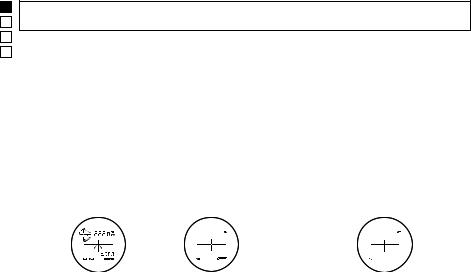
10. Measurement
Es
Fr
Pt
Caution — Controls, adjustments or usage of procedures other than those specified herein may produce negative effects or damage to your health due to laser radiation.
1.Preparing
Install a battery in the battery chamber. (See "Battery")
2.Diopter adjustment
Adjust the diopter to obtain a clear internal display in the viewfinder.
First, rotate the diopter adjustment ring counterclockwise until it comes to a complete stop. Next, rotate the diopter adjustment ring back and forth until the internal display comes into focus.
3.Measuring
Before measuring, be sure to confirm each mode (Measurement display mode/Target priority mode/Distance display unit) setting.
*Please refer to each section on how to set each mode.
3-1. Turn on the power.
(Automatic power shut-off after approx. 8 seconds unoperated.)
3-2. Aim at the target.
Position the target at the center of the target mark.
Immediately after power-on |
Standby |
14
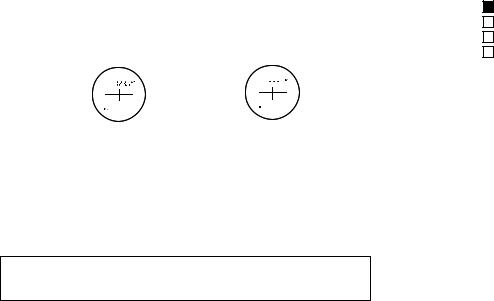
3-3. Press the POWER ON/Measurement button to start measurement.
After measurement, the result is displayed for approx. 8 seconds, then power automatically turns off. If you press the POWER ON/Measurement button during power-on, another measurement starts.
Example of measured distance |
Example of measurement failure |
display |
|
* Continuous measurement function
Press and hold the POWER ON/Measurement button to start continuous measurement up to approx. 8 seconds. During measurement, the measured result is displayed consecutively while the laser irradiation mark is blinking.
If you release your finger from the button, continuous measurement stops.
When measuring a flagstick at a golf course, for example, set First Target Priority mode. Keep targeting the flagstick at the center of the target mark with the continuous measurement function to minimize handshake.
Es
Fr
Pt
15

11. Specifications
Es
Fr
Pt
Measurement system |
|
|
|
|
|
|
|
Measurement range |
7.5-590 meters/8-650 yards |
|
|
(actual distance) |
|
||
|
|
||
|
|
||
|
Actual distance (upper 4-digit): every 0.5m/yd. |
||
|
Actual distance (lower 3-digit): every 1m/yd. |
||
Distance display (increment) |
Horizontal distance/Slope adjusted distance (upper 4-digit): |
||
|
every 0.2m/yd. |
||
|
|
||
|
Height (lower 3-digit): |
every 0.2m/yd. (shorter than 100m/yd.) |
|
|
|
every 1m/yd. (100m/yd. and over) |
|
Optical system |
|
|
|
|
|
|
|
Magnification (x) |
6 |
|
|
|
|
|
|
Effective diameter of objective |
21 |
|
|
lens (mm) |
|
||
|
|
||
Angular field of view (real) (˚) |
7.5 |
|
|
|
|
|
|
Eye relief (mm) |
18.3 |
|
|
|
|
|
|
Exit pupil (mm) |
3.5 |
|
|
|
|
|
|
Diopter adjustment |
±4m-1 |
|
|
Others |
|
|
|
|
|
|
|
Operating temperature (˚C/˚F) |
-10 — +50/14 — 122 |
|
|
|
|
||
Operating humidity (%RH) |
80 or less (without dew condensation) |
||
|
|
|
|
Power source |
CR2 lithium battery x 1 (DC 3V) |
|
|
Automatic power shut-off (after approx. 8 sec. unoperated) |
|||
|
|||
|
|
|
|
Dimensions (L x H x W) (mm/in.) |
112 x 70 x 36/4.4 x 2.8 x 1.4 |
|
|
|
|
||
Weight (g/oz.) |
Approx. 160/5.6 (without battery) |
||
|
|
|
|
16

Structure |
JIS/IEC protection class 4 (IPX4) equivalent (under our testing conditions)* |
|
|
|
|
Electromagnetic compatibility |
FCC Part15 SubPartB class B, EU:EMC directive, AS/NZS, VCCI classB, CU TR 020 |
|
|
|
|
Environment |
RoHS, WEEE |
|
|
|
|
Laser |
|
|
|
|
|
Laser classification |
IEC60825-1: Class 1M/Laser Product |
|
FDA/21 CFR Part 1040.10:Class I Laser Product |
||
|
||
Wavelength (nm) |
905 |
|
|
|
|
Pulse duration (ns) |
12 |
|
|
|
|
Output (W) |
15 |
|
|
|
|
Beam divergence (mrad) |
Vertical: 1.8, Horizontal: 0.25 |
|
|
|
* Water resistance performance
This Nikon Laser Rangefinder is equivalent to JIS/IEC protection class 4 (IPX4) (under our testing conditions). This rating does not guarantee the water resistance performance of the unit or that it will be free from damage or problems under all conditions. Please observe the following when using:
•The unit is not a sealed structure, so it should not be operated nor held in running water.
•If any moisture is found on movable parts of the unit, stop using it and wipe it off.
Es
Fr
Pt
17

12. Troubleshooting/Repair
Es
Fr
Pt
If the Nikon Laser Rangefinder fails to function as expected, check the list before consulting your local dealer or the store where you purchased it.
If there is a problem with the product.
Problem |
Cause/Solution |
Does not turn on |
Press POWER ON/Measurement button (near side, top of the body) |
Check battery insertion |
|
|
Replace the battery with a new one |
|
|
Unable to measure |
Confirm each mode setting |
Confirm if it can measure a large target close to you (example: a |
|
Anomalous result |
building approx. 15 m/yd. ahead of you) |
|
Clean the lens surface if necessary |
|
|
If you require a repair, please contact your local dealer or the store where you purchased the product.
Do not repair or disassemble. It may result in a serious incident.
Please note that Nikon is not responsible for any direct or indirect damage if the user attempts repair or disassembly.
18

|
|
CONTENIDO |
|
|
1. |
Introducción .................................................... |
19-20 |
Español |
2. |
Precauciones antes del uso ........................ |
21-23 |
|
3. |
Características clave ............................................ |
24 |
|
4. |
Nomenclatura/Componentes .......................... |
25 |
|
5. |
Pantalla interna ..................................................... |
26 |
|
6. |
Modo de visualización de la medición ......... |
27 |
|
7. |
Modo de prioridad al sujeto ............................. |
28 |
|
8. |
Unidades de indicación de la distancia ........ |
28 |
|
9. |
Batería ....................................................................... |
29 |
|
1 0. |
Medición ........................................................... |
30-31 |
|
11. |
Especificaciones ............................................. |
32-33 |
|
12. |
Solución de problemas/Reparación .............. |
34 |
En
Fr
Pt
1. Introducción
Muchas gracias por comprar el Nikon Laser Rangefinder COOLSHOT 40i.
Antes de utilizar este producto, lea atentamente estas instrucciones para asegurarse una utilización correcta. Después de leerlo, tenga a mano este manual para consultarlo cuando lo precise.
19

En
Fr
Pt
● Acerca del manual
Ninguna parte del manual incluido con este producto puede ser reproducida, transmitida, transcrita, almacenada en un sistema de recuperación ni traducida a ningún idioma de ninguna forma ni por ningún
medio sin el permiso previo por escrito de Nikon.
Nikon no será considerada imputable por ningún error que pueda contener este manual.El aspecto de este producto y sus especificaciones pueden cambiar sin previo aviso.
●Acerca de los controles sobre radiointerferencia
Este dispositivo cumple con la Parte 15 de las Reglas de la FCC. El funcionamiento está sujeto a las dos condiciones siguientes:
(1)Este dispositivo no puede provocar interferencias peligrosas, y
(2)Este dispositivo debe aceptar cualquier interferencia recibida, incluidas las interferencias que pueden provocar un funcionamiento no deseado.
Este equipo ha sido evaluado y cumple con los límites para un dispositivo digital de clase B, de conformidad con la Parte 15 de las reglas de la FCC y con la directiva sobre CEM de la UE. Estos límites están diseñados
para proporcionar una protección razonable contra la interferencia perjudicial en una instalación residencial. Este equipo genera, usa y puede irradiar energía de frecuencia de radio y, si no se instala y usa de conformidad con las instrucciones, podría causar una interferencia perjudicial a las comunicaciones de radio. Sin embargo, no hay garantía de que la interferencia no ocurra en una instalación particular.
Si el equipo provoca perturbaciones en la recepción de radio o televisión, lo que se puede comprobar apagando y volviendo a encender el equipo, el usuario debería intentar corregir la interferencia mediante una o más de las medidas siguientes:
•Reoriente o reubique la antena receptora.
•Aumente la separación entre el equipo y el receptor.
•Consulte al distribuidor o a un técnico de televisión/radio experimentado.
Este aparato digital de Clase B cumple todos los requisitos de las Regulaciones Canadienses sobre Equipos que Provocan Interferencias.
●Acerca de los resultados de medición
Este Nikon Laser Rangefinder es un telémetro básico. Sus resultados no se pueden utilizar como prueba oficial.
20

2. Precauciones antes del uso
Respete estrictamente las orientaciones siguientes para utilizar correctamente el equipo y evitar accidentes que podrían ser peligrosos. Antes de utilizar el producto lea atentamente las "Precauciones antes del uso" y las instrucciones de uso correcto que acompañan al producto. Tenga a mano este manual para consultarlo cuando lo precise.
 ADVERTENCIA
ADVERTENCIA
Esta indicación le avisa que un uso incorrecto que no tenga en cuenta este punto puede provocar la muerte o heridas graves.
 PRECAUCIÓN
PRECAUCIÓN
Esta indicación le advierte que cualquier utilización inadecuada que ignore el contenido aquí incluido puede provocar lesiones o pérdidas materiales.
PRECAUCIONES DE SEGURIDAD (Láser)
El Nikon Laser Rangefinder utiliza un haz láser invisible. Asegúrese de respetar lo siguiente:
 Advertencia
Advertencia
•No pulse el botón POWER ON/ Measurement (encendido/medición) mientras mira la óptica desde el lado del objetivo. Si lo hace sus
ojos podrían verse afectados negativamente o lesionados.
•No apunte al ojo.
•No apunte a personas con el láser.
•No mire al láser con ningún otro instrumento óptico, por ejemplo a través de lentes o binoculares, ni
tampoco directamente sin protección ocular. Si lo hace, su visión podría resultar dañada.
•Cuando no esté realizando mediciones, mantenga los dedos apartados del botón POWER ON/ Measurement (encendido/medición) para evitar la emisión accidental de un haz láser.
•Si no va a utilizarlo durante un período prolongado, retire la batería del cuerpo.
•No desmonte/remodele/repare el Nikon Laser Rangefinder. El láser emitido podría ser nocivo para su salud. Un producto que haya sido desmontado/remodelado/ reparado pierde la garantía del fabricante.
•Mantenga el Nikon Laser Rangefinder fuera del alcance de los niños cuando lo guarde.
•Si la carcasa del Nikon Laser Rangefinder está dañada o si emite un ruido raro después de una caída o por cualquier otra causa, retire la batería inmediatamente y deje de usarlo.
En
Fr
Pt
21
